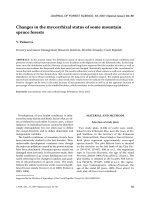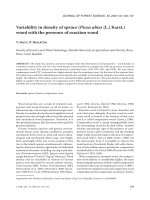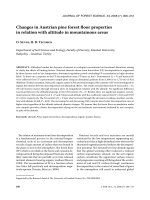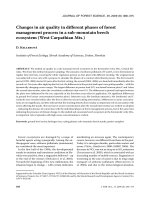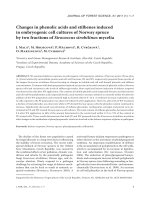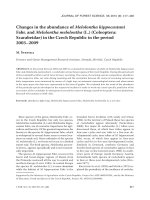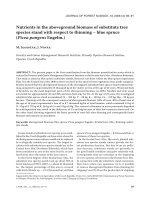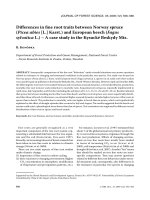Báo cáo lâm nghiệp: "Changes in endogenous cytokinins during flowering induction in Douglas fir: effect of exogenous applications N. Imbau" potx
Bạn đang xem bản rút gọn của tài liệu. Xem và tải ngay bản đầy đủ của tài liệu tại đây (434.38 KB, 4 trang )
Changes
in
endogenous
cytokinins
during
flowering
induction
in
Douglas
fir:
effect of
exogenous
applications
N. Imbault
P.
Doumas
2
C. Joseph
M.
Bonnet-Masimbert
2
1
Laboratoire
des
Composes
Ph6noliques,
Universite
d’Orl6ans,
45067
Orl6ans
Cedex,
and
2
INRA,
Station
dAmelioration
des
Arbres
Forestiers,
Ardon,
45160
Olivet,
France
Introduction
The
involvement
of
plant
growth
sub-
stances
(PGS)
in
flowering
promotion
in
conifers
was
analyzed
in
relation
to
the
level
of
gibberellins
(Pharis
et
al.,
1987).
However,
in
herbaceous
species,
cyluki-
nins
are
sometimes
considered
as
one
of
the
components
which
promote
flowering
(Bernier
2
t al.,
1977;
Lejeune
et al.,
1988).
In
Douglas
fir,
some
treatments,
such
as
fertilization,
stem
girdling,
root
pruning
or
root
flooding,
can
favor
flowering
(Bonnet-
Masimbert,
1982).
Roots
are
also
conside-
red
to
be
the
major
site
of
cytokinin
synthesis
(Kende,
1964).
Endogenous
cy-
tokinins
were
analyzed
in
Douglas
fir,
ini-
tially
in
the
sexual
buds
and
then
in
the
shoots
during
floral
differentiation.
Then,
the
observed
changes
in
the
compound
assimilated
to
isopentenyladenine
(iP)
led
to
the
study
of
an
effect
of
this
compound
on
flowering.
Materials
and
Methods
;’
" uai
bods
oí
Douglas
fir
(Pseudofsuga
men-
!ir
"
’1
.
’1
<:;>11;><:1;>d
from
1he
same
10
yr
old
tree
in
April
during
the
time
of
’bud
develop-
ment’.
Shoots
were
collected
from
5
yr
old
ramets
of
the
same
clone.
They
were
subjected
to
dif-
ferent
treatments
at
the
time
of
bud
burst:
1)
control;
2)
stem
perfusion
of
an
aqueous
solution
of
gibberellins
A
4n
plus
naphthyl
acetic
acid;
3)
alternate
root
flooding
(2
1/2
d
in
water
and
2
1/2
d
out)
for
3
wk;
4)
combination
of
treatments
2
and
3.
Shoots
were
collected
3
and
6
wk
after
bud
burst.
Exogenous
iP
was
applied
to
shoots
of
6
yr
old
trees.
Cytokinin
bases
and
ribosides
were
extracted
and
analyzed
as
described
by
Imbault
et
al.
(1988).
Cytokinin
nucleotides
were
extracted
with
10°f°
perchloric
acid,
purified
on
a
cellulose
phosphate
column
and
on
a
carboxylic
acid
column
before
separation
by
high
performance
liquid
chromatography
(HPLC)
using
an
anion
exchange
column
Partisil
10
SAX
(Whatman)
to
separate
the
mono-,
di-
and
triphosphate
cytokinins,
and
a
C18
column
(Beckman
Ultra-
spher,
5
pm)
to
separate
the
compounds
of
the
zeatin
family
from
those
from
the
iP
family
in
the
monophosphate
zone
(Laloue,
personal
communication).
Cytokinins
cochromatograph-
ing
with
standards
and
which
were
recognized
by
antibodies
directed
against
isopentenyla-
denosine
(iPA)
or
ribosylzeatin
(RZ)
were
quan-
tified
by
radioimmunoassay.
In
another
experiment,
iP
was
exogenously
applied.
The
modalities
consisted
of
the
appli-
cation
of
3
quantities
of iP
(0,
0.5,
5
!ig):
2
types
of
solvent
(ethanol
or
water
with
0.05%
Aromox
C);
2
zones
of
application
(distal
1l3
or
proximal
2/3
of
the
shoot);
2
dates
of
application
(3
or
6
wk
after
individual
bud
burst).
The
following
spring,
male
and
female
strobili
were
counted
on
each
shoot.
Results
Cytokinin
bases
and
ribosides
were
ana-
lyzed
in
the
sexual
buds.
Male
and
female
buds
presented
the
same
peaks,
corre-
sponding
to
the
iP,
iPA,
zeatin
and
RZ
retention
times.
There
was
a
supplemen-
tary
peak
before
the
RZ
one
in
the
female
buds;
this
peak
has
not
yet
been
identi-
fied.
We
did
not
observe
any
differences
in
forms
of
the
monophosphate
nucleo-
tides.
They
had
the
same
retention
time
peaks
as
RZ
monophosphate,
dihydro-
zeatin
monophosphate
and
iPA
mono-
phosphate
standards
(Fig.
1
This
uni-
dentified
peak
had
neither
the
same
retention
time
as
the
iPA
monophosphate
standard
nor
that
of
the
iP
or
the
iPA
stan-
dard
but
it
reacted
with
the
anti-iPA
anti-
bodies.
It
could
correspond
to
another
form
of
cytokinin
nucleotides.
Bases
and
ribosides
were
also
ana-
lyzed
in
Douglas
fir
shoots
during
floral
differentiation
after
induction
by
different
treatments.
Only
the
iP-iPA
zone
is
pre-
sented.
Fig.
2a
shows
the
results
of
com-
pounds
cochromatographing
with
iPA.
The
quantities
of
iPA
were
not
related
to
the
flowering
or
to the
treatment.
Compounds
cochromatographing
with
iP
are
repre-
sented
in
Fig.
2b.
Like
iPA,
no
relation
could
be
established
between
the
treat-
ments
and
the
iP
rate;
but
there
seemed
to
be
a
relationship
between
the
iP
rate
and
female
flowering.
In
our
other
experiment,
exogenous
iP
was
applied
to
shoots
to
confirm
its
pos-
sible
effect
on
flowering.
iP
had
no
signifi-
cant
effect
on
male
flowering
(Fig.
3a)
but
it
had
a
positive
effect
on
female
flowering
(Fig.
3b)
at
the
highest
dosage
(5
J1
g
per
shoot)
and
in
the
early
treatments
(3
wk
after
bud
burst),
given
at
a
time
when
floral
differentiation
could
occur
(Owens,
1969).
r!-
’&dquo; r-u__
-I 1
a:«
a-,:.:
-I.
:-
,:
Conclusion
Besides
gibberellins
and
probably
some
other
PGS,
iP
may
be
one
of
the
compo-
nents
involved
in
hormonal
regulation
of
flower
promotion
in
Douglas
fir.
However,
it
is
certainly
not
the
only
one
and
these
results
will
be
compared
later
to
those
obtained
with
other
PGS
in
the
same
shoots.
References
Bernier
G.,
Kinet
J.M.,
Jacmard
A.,
Havelange
I.
&
Bodson
M.
(1977)
Cytokinin
as
a
possible
component
of
a
floral
stimulus
in
Sinapis
alba.
Plant
Physiol.
60,
282-285
Bonnet-Masimbert
M.
(1982)
Influence
de
1’6tat
d’activit6
des
racines
sur
la
floraison
induite
par
les
gibberellines
4
et
7
chez
Pseudotsuga
menziesii
(Mirb.)
Franco.
Silvae
Genet.
21, 178-
188
lmbault
N.,
Tardieu
I.,
Joseph
C.,
Zaerr
J.B.
&
Bonnet-Masimbert
M.
(1988)
Possible
role
of
isopentenyladenine
and
isopentenyladenosine
in
flowering
of
Pseudotsuga
menziesii:
endo-
genous
variations
and
exogenous
applications.
Plant
Physiol.
Biochem.
26,
289-295
Kende
H.
(1964)
Preservation
of
chlorophyll
in
leaf
sections
by
substances
obtained
from
root
exudates.
Science
163, 1066-1067
Lejeune
P.,
Bernier
G.
&
Kinet
J.M.
(1988)
Cytokinin
fluxes
during
floral
induction
in
the
long
day
plant
Sinapis
alba
L.
Plant
Physiol.
86,
1095-1098
Owens
J.N.
(1969)
The
relative
importance
of
initiation
and
early
development
on
cone
pro-
duction
in
Douglas
fir.
Can.
J.
Bot.
47,
1030-
1049
Pharis
R.P.,
Webber
J.E.
&
Ross
S.D.
(1987)
The
promotion
of
flowering
in
forest
trees
by
gibberellin
A4/7
and
cultural
treatments:
a
review
of
the
possible
mechanisms.
For.
Ecol.
Manage.
19,
65-84
